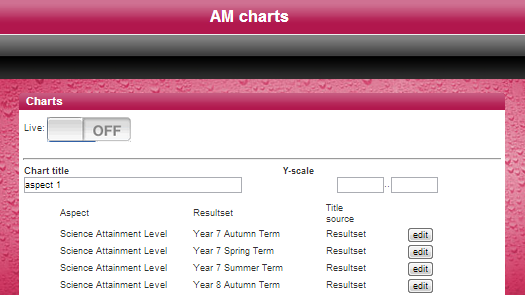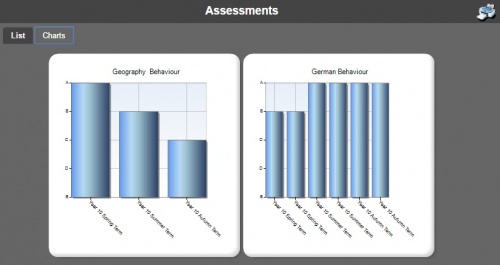AM charts
The AM charts page is used to configure bar charts that appear on the assessments page (users will need the "Show progress charts" role option enabled to see the charts). The bar charts will show grades that have been recorded in SIMS Assessment Manager.
The charts can either be configured via the AM charts page, or by editing a text file on the IIS server that hosts Insight.
Using the AM charts page
To create a new chart, scroll to the bottom of the AM charts page to find a blank section.
The chart will need to be given a title first. Then click the edit button on the right to open a window where you can select an aspect and resultset. This will
This screen allows you to create any number of charts to be displayed and allows you to specify which Aspect and Resultset pairs you wish to use for each chart element.
Here's how it looks...

Toward the top of the screen is a switch that will turn 'On' your custom charts.
If this is 'Off', the default charts will be displayed in line with the users 'Role Options'. If it is 'On' , your configuration will be used.
Below this, you will see a number of repeated chart configurations, initially just for the one new item.
Each chart is comprised of three things:
1. A Title - This will be displayed next to the chart.
2. An Optional Y-Scale - Automatically chosen for the user each time unless you provide an override.
3. A set of Aspect and Resultset Pairs - these supply the data within the chart.
To add a new Aspect/Resultset pair to a chart -
Click the 'Edit' button located to the right of an empty or configured line.
You will be asked to select an Aspect and a Resultset.
Separately, you will need to select how the X-Axis label of the column will be identified (You can use either OR both Aspect and Resultset names).
You can continually add new charts and columns to charts, although it is advisable to periodically check how they appear to a user.
Using the text file on the IIS server
On the web server, under the main Insight folder is another folder named "_Personalisation". This folder is used to record changes to your set up which will not be reversed by applying service packs. Inside the "_Personalisation" folder, you will initially find a file named "assessments.charts.unused". The "unused" portion tells Insight not to use the contents of the file, so to define your own charts, in the first instance rename the file to remove the ".unused" from the end of the filename.
Open the "assessments.charts" file in a text editor such as Notepad. You will see the definition of some sample charts, which because they are not specifically designed for your school are unlikely to work out of the box.
The first sample represents a chart showing nine samples of a single aspect over Key Stage 3.
<chart id="aspect 1" /> <aspect chart="aspect 1" aspect="Science Attainment Level" resultset="Year 7 Autumn Term" xlabel="r" /> <aspect chart="aspect 1" aspect="Science Attainment Level" resultset="Year 7 Spring Term" xlabel="r"/> <aspect chart="aspect 1" aspect="Science Attainment Level" resultset="Year 7 Summer Term" xlabel="r"/> <aspect chart="aspect 1" aspect="Science Attainment Level" resultset="Year 8 Autumn Term" xlabel="r"/> <aspect chart="aspect 1" aspect="Science Attainment Level" resultset="Year 8 Summer Term" xlabel="r"/> <aspect chart="aspect 1" aspect="Science Attainment Level" resultset="Year 8 Spring Term" xlabel="r"/> <aspect chart="aspect 1" aspect="Science Attainment Level" resultset="Year 9 Autumn Term" xlabel="r"/> <aspect chart="aspect 1" aspect="Science Attainment Level" resultset="Year 9 Spring Term" xlabel="r"/> <aspect chart="aspect 1" aspect="Science Attainment Level" resultset="Year 9 Summer Term" xlabel="r"/>
In explanation, the first line states that there is to be a chart, and it will be identified as "aspect1". You could call this pretty much anything, and this will also be used as the title for the chart.
After the "chart" line follow a number of "aspect" lines, each of which represent a column in the eventual chart. Each "aspect" line contains a number of parameters. The first ties the line to a particular chart, so the value of "chart=" should normally be the same as the "id=" value from the preceding "chart" row.
Next follow the name of the aspect and result-set respectively. These need to match exactly the names defined in SIMS.
Lastly there is an "xlabel" parameter, which defined the title for that column on the chart. You can use "r" to designate that the name of the result set should be used - as the aspect stays the same in this example, this is what is used. For the aspect name, you could use "a", or in the case of the last column in the sample, "ar".
You can use the same result-set for each column if required, and show different aspects from the same sample. This is represented by the second sample:
<chart id="English Levels" /> <aspect chart="English Levels" aspect="EN KS2: English Test Lev" resultset="Key Stage 2 Validated Result" xlabel="a"/> <aspect chart="English Levels" aspect="EN KS2: Reading Test Level" resultset="Key Stage 2 Validated Result" xlabel="a"/> <aspect chart="English Levels" aspect="EN KS2: Writing Test Level" resultset="Key Stage 2 Validated Result" xlabel="a"/>
In this example, three different Key Stage 2 aspects as recorded in the same result-set are plotted against each other. In this case the column titles are set to be the name of the aspect. It is expected that the y axis scale for the three aspects are of the same order of magnitude, or are suitable for direct comparison.
If one of the aspects used were to be a target or base line figure and not sampled in result-sets, a slightly difference is used in the format of the result-set parameter.
<chart id="dunno" yscale="0..20"/> <aspect chart="dunno" aspect="2 Levels Progress English" resultset="" xlabel="a"/> <aspect chart="dunno" aspect="2 Levels Progress Maths" resultset="" xlabel="a"/> <aspect chart="dunno" aspect="EN KS2: Writing Test Level" resultset="Key Stage 2 Validated Result" xlabel="a"/>
In this example the first two columns represent result-set less aspects, and so the result-set name is left empty. As expected the column title will be the name of the aspect.
Additionally in this example, which mixes aspects in an unlikely way, it is also necessary to define a scale for the y axis. This may sometimes be necessary when grades are likely to clump near the top or bottom of a scale, to the degree that the automatically selected extends may not be suitable.
